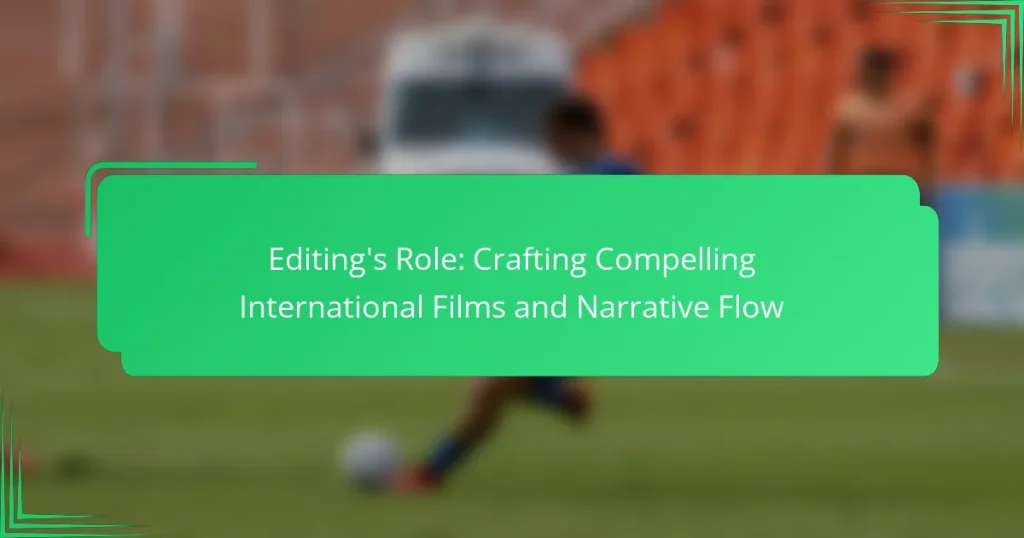Editing plays a crucial role in shaping international film narratives, influencing the flow, pacing, and emotional resonance of the story. By employing techniques such as continuity editing and montage sequences, editors can enhance coherence and engage diverse audiences while accurately conveying cultural nuances. Selecting the right editing software is essential for achieving these goals, with options like Adobe Premiere Pro and Final Cut Pro catering to various needs and expertise levels.
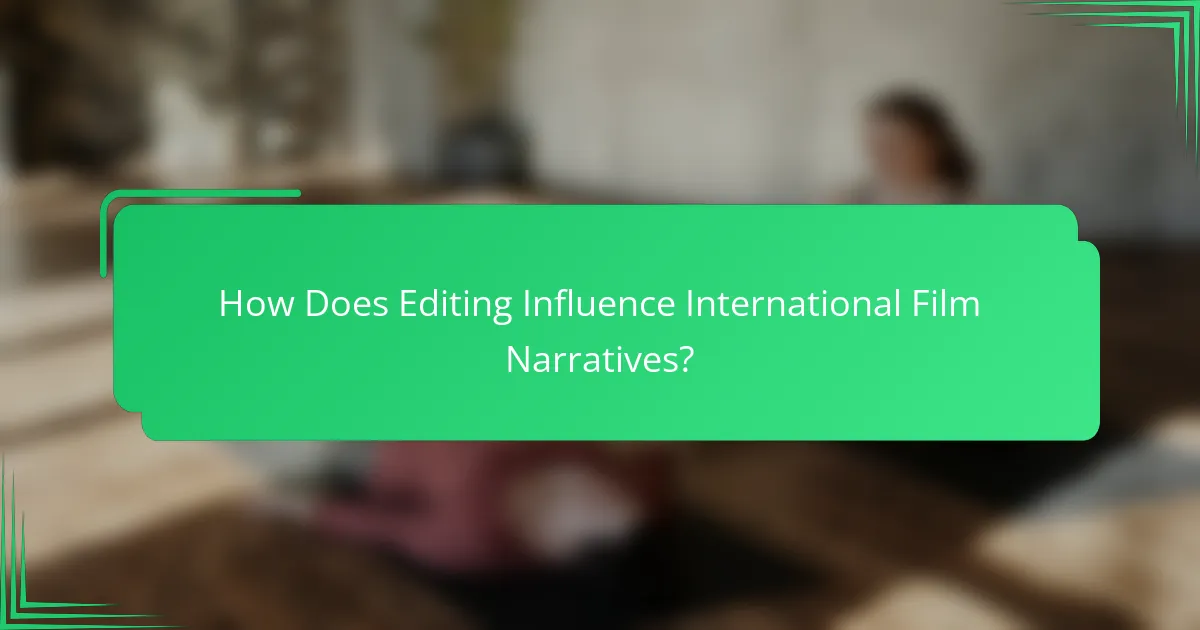
How Does Editing Influence International Film Narratives?
Editing plays a crucial role in shaping international film narratives by determining the flow, pacing, and emotional impact of the story. Effective editing can enhance coherence, evoke emotions, and ensure cultural nuances are conveyed accurately to diverse audiences.
Enhances storytelling coherence
Editing enhances storytelling coherence by organizing scenes and sequences in a way that makes the narrative easy to follow. A well-edited film maintains logical progression, ensuring that viewers can connect with the plot and characters without confusion.
To achieve coherence, editors often use techniques such as continuity editing, which preserves spatial and temporal consistency. For instance, matching action and maintaining eye-line matches can help audiences stay engaged with the story.
Shapes audience emotional responses
Editing shapes audience emotional responses by controlling the rhythm and timing of scenes. The choice of cuts, transitions, and pacing can significantly influence how viewers feel during critical moments, such as building tension or providing relief.
For example, quick cuts during an action sequence can create excitement, while longer takes in a dramatic scene can evoke empathy. Editors should consider the emotional arc of the film and align editing choices with the intended audience experience.
Facilitates cultural context
Editing facilitates cultural context by ensuring that local customs, languages, and social norms are accurately represented in the film. This is particularly important for international audiences who may not be familiar with the cultural background of the story.
Editors can incorporate subtitled dialogue, culturally relevant imagery, and pacing that reflects local storytelling traditions. For instance, films from different regions may have varying expectations for humor or dramatic tension, which editors must navigate to resonate with diverse viewers.
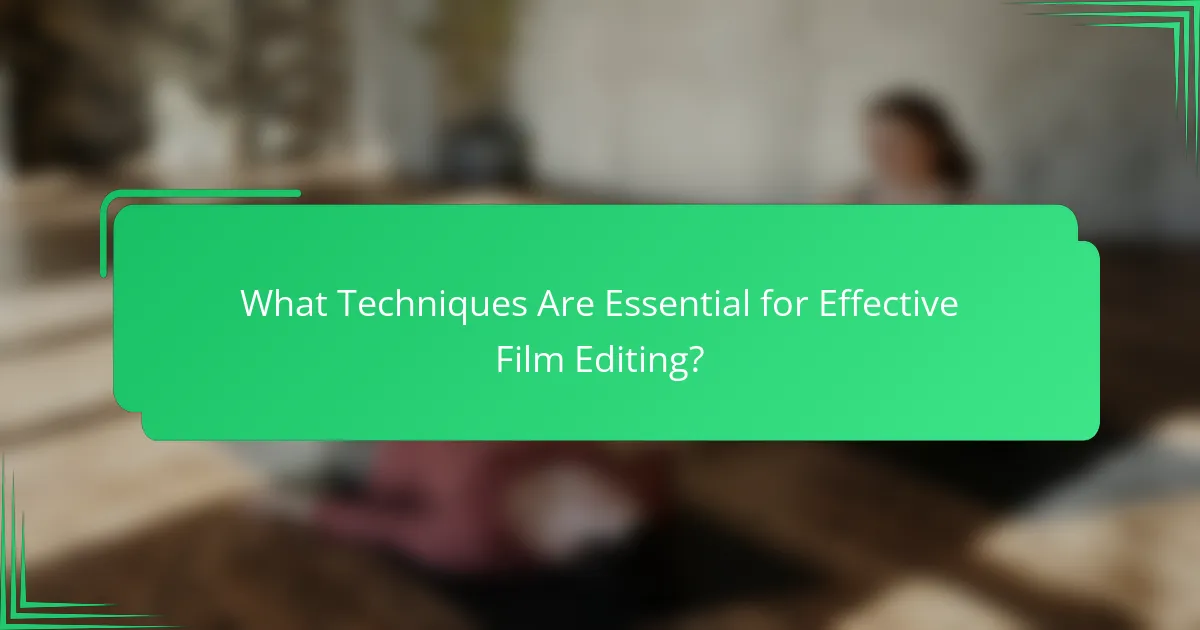
What Techniques Are Essential for Effective Film Editing?
Effective film editing relies on techniques that enhance narrative flow and maintain viewer engagement. Key methods include continuity editing, montage sequences, and color grading, each serving distinct purposes in storytelling and visual coherence.
Continuity editing
Continuity editing aims to create a seamless flow of action and maintain spatial and temporal consistency. This technique ensures that scenes transition smoothly, allowing viewers to follow the story without confusion. Editors often use techniques like the 180-degree rule and match cuts to preserve continuity.
Common pitfalls in continuity editing include mismatched eyelines or inconsistent props, which can distract the audience. To avoid these issues, always double-check footage for alignment and coherence during the editing process.
Montage sequences
Montage sequences condense time and convey complex ideas through a series of rapid images or scenes. This technique can effectively illustrate character development or thematic elements by juxtaposing contrasting shots. For instance, a montage might show a character’s journey through various challenges in just a few minutes.
When crafting montages, consider pacing and rhythm. A well-timed montage can evoke strong emotions, while a poorly executed one may confuse viewers. Aim for a balance between visual variety and thematic clarity to maximize impact.
Color grading
Color grading enhances the visual tone of a film, influencing mood and atmosphere. By adjusting colors, contrast, and brightness, editors can create a cohesive look that aligns with the film’s narrative. For example, warmer tones might evoke nostalgia, while cooler tones can suggest tension or unease.
When color grading, be mindful of the film’s genre and target audience. Different styles resonate with various demographics, so tailor your approach accordingly. Additionally, using color grading software can streamline the process, allowing for precise adjustments and creative experimentation.

Which Editing Software Is Best for International Films?
The best editing software for international films depends on your specific needs, budget, and familiarity with the tools. Popular choices include Adobe Premiere Pro, Final Cut Pro, and Avid Media Composer, each offering unique features suited for different aspects of film editing.
Adobe Premiere Pro
Adobe Premiere Pro is widely used in the film industry for its flexibility and integration with other Adobe products. It supports a variety of formats and provides powerful tools for color correction, audio editing, and effects.
One of its key advantages is the collaborative features, allowing multiple editors to work on a project simultaneously. This can be particularly beneficial for international teams working across different time zones.
Final Cut Pro
Final Cut Pro is known for its user-friendly interface and robust performance on Mac systems. It offers advanced features like magnetic timeline and multi-cam editing, which streamline the editing process.
This software is ideal for filmmakers who prioritize speed and efficiency, especially when working with high-resolution footage. However, it is exclusive to macOS, which may limit accessibility for some users.
Avid Media Composer
Avid Media Composer is a staple in professional film editing, especially for large-scale productions. It excels in managing complex projects and offers powerful media management tools, making it suitable for international films with extensive footage.
While it has a steeper learning curve compared to other software, its capabilities in collaborative workflows and version control are unmatched. This makes it a preferred choice for editors working in teams on high-budget international films.
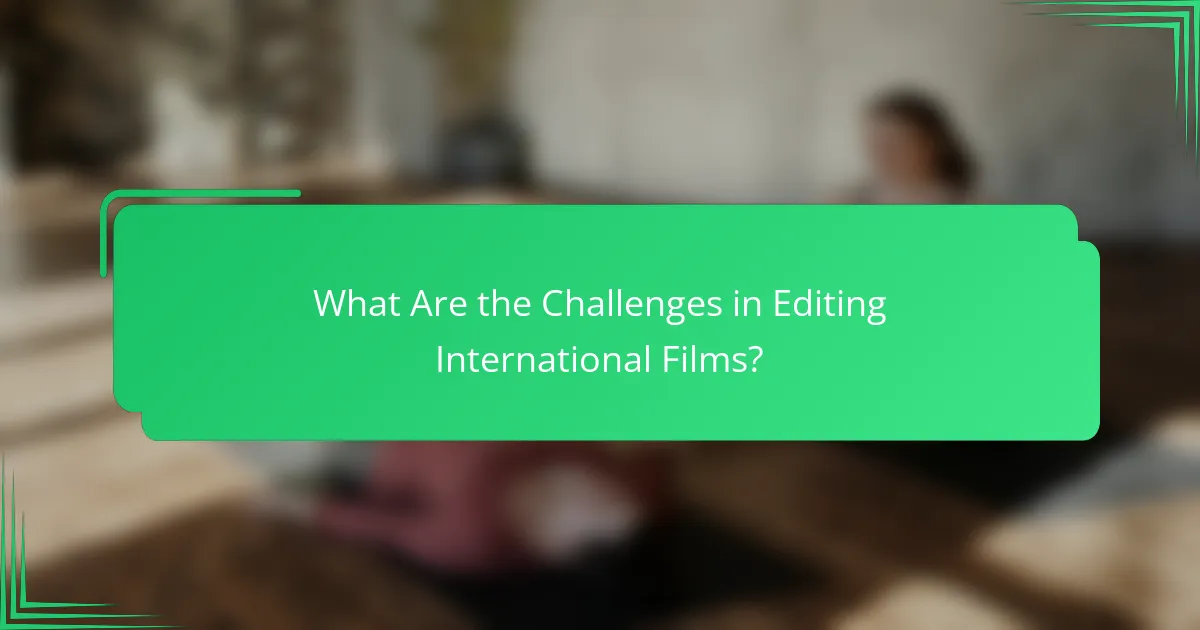
What Are the Challenges in Editing International Films?
Editing international films presents unique challenges, primarily due to cultural differences, language barriers, and logistical issues like time zone coordination. These factors can significantly impact narrative flow and audience engagement, requiring editors to navigate complex dynamics to create a cohesive final product.
Cultural differences in storytelling
Cultural differences can shape how stories are told and perceived, influencing narrative structure, character development, and thematic elements. For instance, a film that resonates well in one culture may not have the same impact in another due to varying values and social norms.
Editors must be sensitive to these differences, ensuring that the story aligns with the cultural context of the target audience. This may involve adjusting pacing, altering scenes, or even reinterpreting character motivations to enhance relatability and emotional connection.
Language barriers in dialogue
Language barriers can complicate the editing process, particularly when dealing with multilingual scripts or subtitles. Editors must ensure that dialogue flows naturally and maintains the intended meaning across different languages, which may require careful localization rather than direct translation.
To address this, editors should collaborate closely with translators and language experts, reviewing dialogue for cultural nuances and idiomatic expressions. This helps preserve the film’s voice while making it accessible to diverse audiences.
Time zone coordination for teams
Time zone differences can pose significant challenges for international editing teams, affecting communication and project timelines. Coordinating schedules across multiple regions often leads to delays in feedback and decision-making, which can hinder the editing process.
To mitigate these issues, teams should establish clear communication protocols and utilize collaborative tools that accommodate different time zones. Setting regular check-ins and deadlines can help keep the project on track and ensure that all team members are aligned on goals and progress.
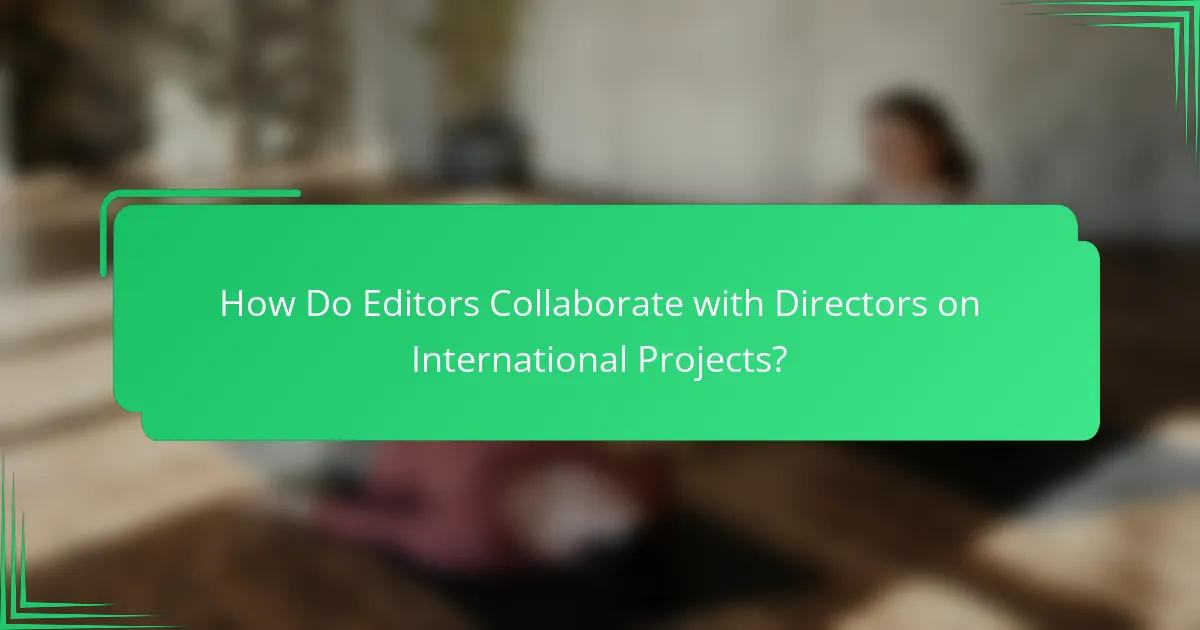
How Do Editors Collaborate with Directors on International Projects?
Editors work closely with directors on international projects to ensure that the narrative flows seamlessly across cultural and linguistic boundaries. This collaboration involves regular communication, aligning creative visions, and utilizing various tools to enhance the editing process.
Regular feedback sessions
Regular feedback sessions are crucial for maintaining a cohesive vision between editors and directors. These meetings often occur at various stages of the editing process, allowing for real-time adjustments and creative input. Scheduling these sessions weekly or bi-weekly can help keep the project on track and address any emerging issues promptly.
During feedback sessions, directors can provide insights on pacing, tone, and emotional impact, while editors can suggest technical adjustments that enhance the overall quality. This iterative process fosters a collaborative environment where both parties can express their ideas and concerns openly.
Shared vision alignment
Aligning on a shared vision is essential for successful collaboration between editors and directors. This involves discussing the film’s themes, target audience, and stylistic choices early in the project. Establishing a clear understanding of the intended message helps guide editing decisions and ensures that the final product resonates with viewers across different cultures.
Directors should articulate their creative goals, while editors can offer insights on how to achieve those goals through editing techniques. This alignment can be documented in a creative brief, which serves as a reference point throughout the editing process.
Use of collaborative tools
Utilizing collaborative tools can significantly enhance the editing process for international projects. Software like Adobe Premiere Pro, Avid Media Composer, and DaVinci Resolve offer features that facilitate real-time collaboration, allowing editors and directors to work together, even from different locations.
Additionally, cloud-based platforms such as Frame.io or Wipster enable teams to share feedback and make annotations directly on the footage. This streamlines communication and helps ensure that everyone is on the same page, reducing the risk of misinterpretation and enhancing the overall efficiency of the editing workflow.
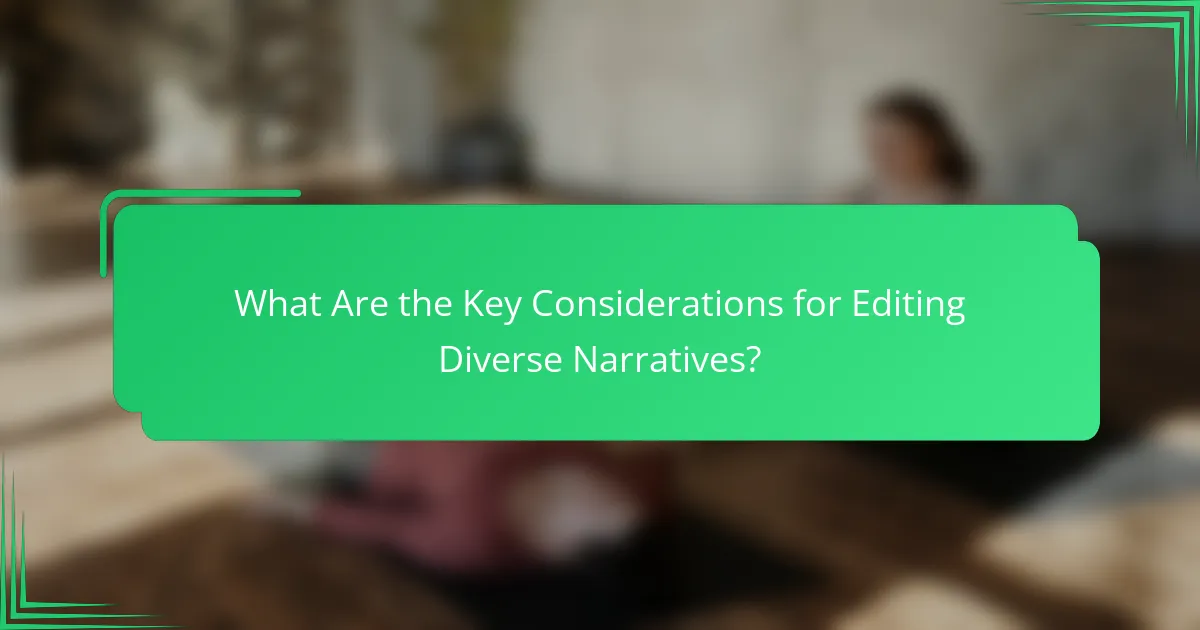
What Are the Key Considerations for Editing Diverse Narratives?
Editing diverse narratives requires a focus on representation, authenticity, and audience engagement. These elements ensure that the story resonates with a wide range of viewers while maintaining cultural integrity.
Representation and authenticity
Representation and authenticity are crucial in editing diverse narratives. Editors must ensure that characters and stories reflect the cultures they represent, avoiding stereotypes and clichés. This involves collaborating with cultural consultants or individuals from the represented communities to validate the narrative’s accuracy.
For example, when editing a film that features a specific cultural background, it is essential to portray customs, language, and social dynamics accurately. This not only enriches the narrative but also fosters respect and understanding among audiences.
Audience engagement strategies
Engaging audiences in diverse narratives requires tailored editing strategies that resonate with different cultural perspectives. Editors should consider pacing, visual storytelling, and emotional beats that align with the target audience’s expectations and experiences.
Utilizing techniques such as cliffhangers, relatable character arcs, and culturally relevant humor can enhance viewer investment. Additionally, incorporating subtitles or dubbing in local languages can broaden accessibility and deepen audience connection.
